The Gecko Nebula is a reflection nebula located in the faint northern constellation of Lacerta (the Lizard). It is listed as LBN 437 in the Lynds’ Catalogue of Bright Nebulae. The cosmic Gecko is part of a larger molecular cloud that includes several other diffuse nebulae.
The nebula was nicknamed the Gecko because its clouds outline a shape similar to that of a small lizard. The tip of the nebula points in the direction of the star 10 Lacertae. The hot blue main sequence star ionizes the neighbouring Great Lacerta Nebula (Sharpless 126, Sh2-126), a large emission nebula about 3 degrees across. The star appears 1.8 southeast of the Gecko Nebula.
The Gecko Nebula consists of luminous ionized gas clouds, several unilluminated clouds and several small reflection nebulae illuminated by the young stars embedded within them. It is a large cometary globule, an interstellar cloud shaped like a comet, composed of a compact, opaque head and a long tail, associated with a hot, ionized stellar nursery.
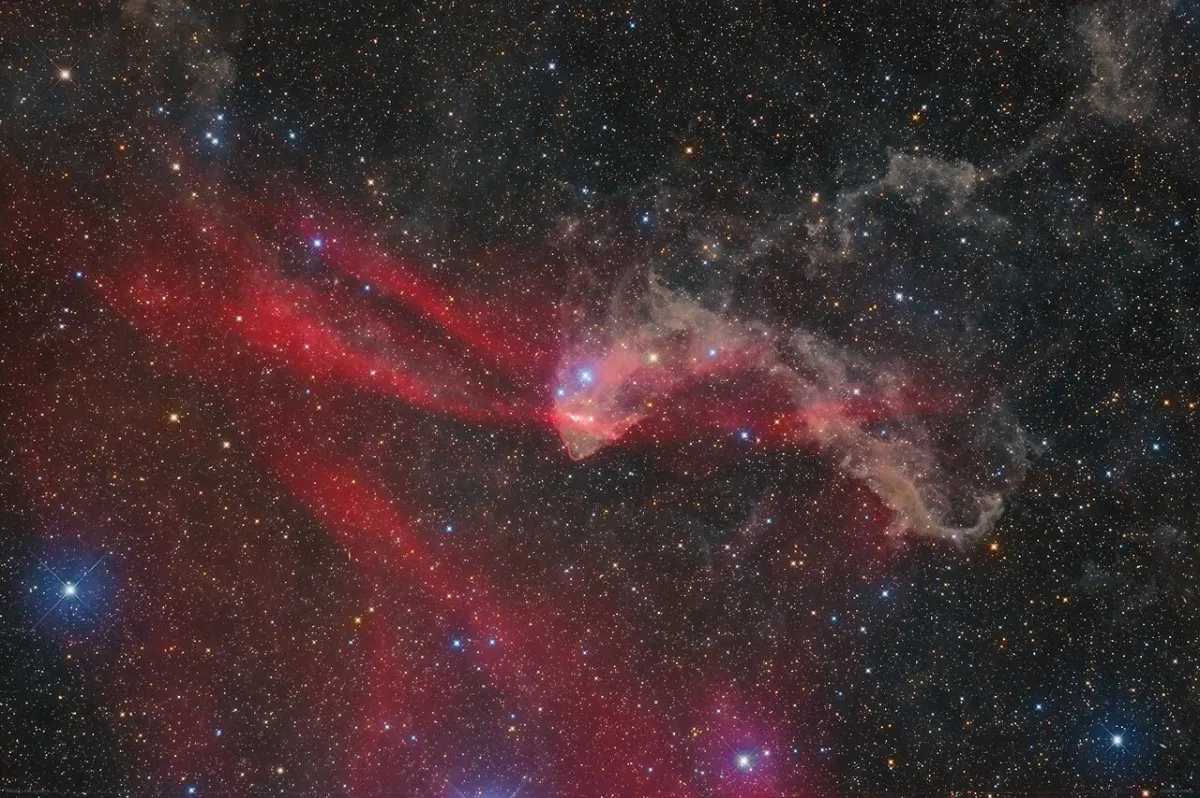
The Gecko Nebula (LBN 437) and the Great Lacerta Nebula (Sh2-126), image credit: Carsten Frenzl (CC BY 2.0)
Cometary globules form at the edges of star forming regions, where ultraviolet radiation from the young stars compresses and shapes the surrounding material, creating an ionized bubble. As the bubble expands, it forms a compressed molecular shell that eventually becomes either a cometary globule, pillar, trunk, or similar structure that protrudes into the ionized gas.
The densest part of the Gecko Nebula is home to very young stars. The nebula contains several Herbig-Haro objects, small patches of nebulosity found around newly formed stars. The star formation in the cloud is believed to be the result of interaction between the cloud and the ionizing light from the massive members of the Lacerta OB1 association.
A young stellar object catalogued as LkHa 233 (V375 Lacertae) forms a small, symmetrical reflection nebula within the Gecko. It is a Herbig Ae/Be star – an intermediate-mass pre-main-sequence star – with a collimated bipolar jet.
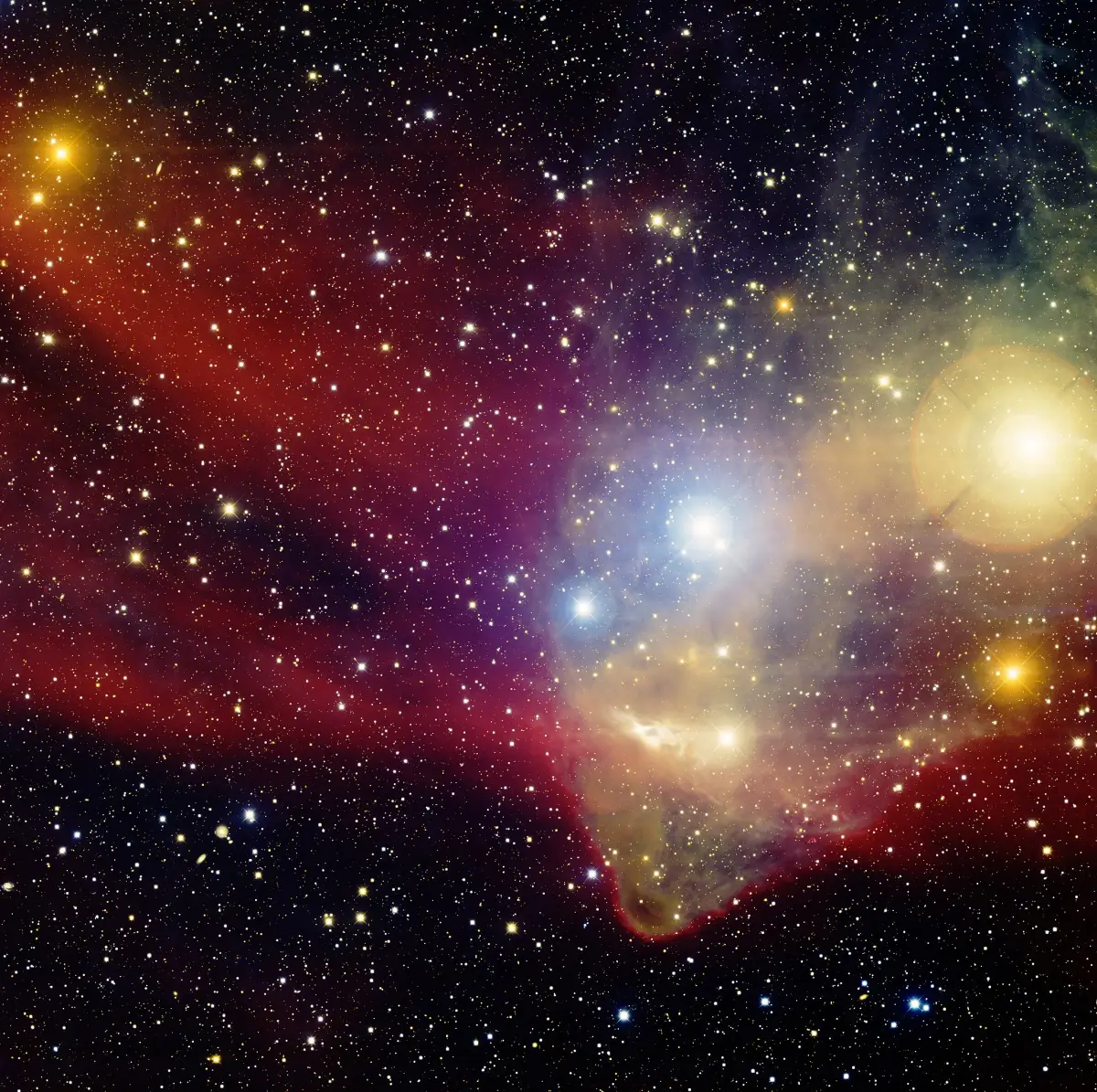
This image was obtained with the wide-field view of the Mosaic camera on the Mayall 4-meter telescope at Kitt Peak National Observatory. Informally known as the ‘star funnel’, this dark nebula is yellowish in color because it is being illuminated by several bright stars nearby. The funnel is embedded in a larger nebula of warm hydrogen gas that is glowing red. The image was generated with observations in B (blue), V (green), I (orange) and Hydrogen-Alpha (red) filters. In this image, North is up, East is to the left. Image credit: T.A. Rector (University of Alaska Anchorage) and H. Schweiker (WIYN and NOIRLab/NSF/AURA) (CC BY 4.0)
The neighbouring Great Lacerta Nebula (Sh2-126, LBN 428) is a vast H II region located approximately 1,200 light years away. The glowing cloud of hydrogen gas is one of the largest nebulae in the sky, appearing about as large as the Andromeda Galaxy (Messier 31). It is sometimes known as the Scarlet Letter Nebula because its clouds form a shape similar to the letter A. It shares this nickname with the emission nebula Sh2-96, which is part of a large supernova remnant in the constellation Cygnus.
10 Lacertae, a blue main sequence star of the spectral type O9V, is the ionising source of the 10 Lacertae nebula complex, of which Sh2-126 is the most prominent part. The star’s intense ultraviolet light energizes the nearby clouds of hydrogen gas, making them glow red. The yellowish white Gecko appears juxtaposed against the red emission clouds of Sh-126.
The Gecko Nebula and Sh2-126 are part of a large star-forming region that also includes the elongated molecular cloud GAL 110-13 in the neighbouring constellation Andromeda. The molecular cloud is more than 1.5 degrees across.
With an apparent magnitude of 4.880, the massive O-type star 10 Lacertae is faintly visible to the unaided eye. It has 21.6 times the Sun’s mass and is 69,200 times more luminous. The star is a member of the Lacerta OB1 association, a family of exceptionally hot and massive young stars that are in the final stage of star formation. These stars are surrounded by the remnant molecular clouds in which they formed. The entire Lacerta molecular cloud complex, along with its delicate faint filaments, is part of Lacerta OB1.
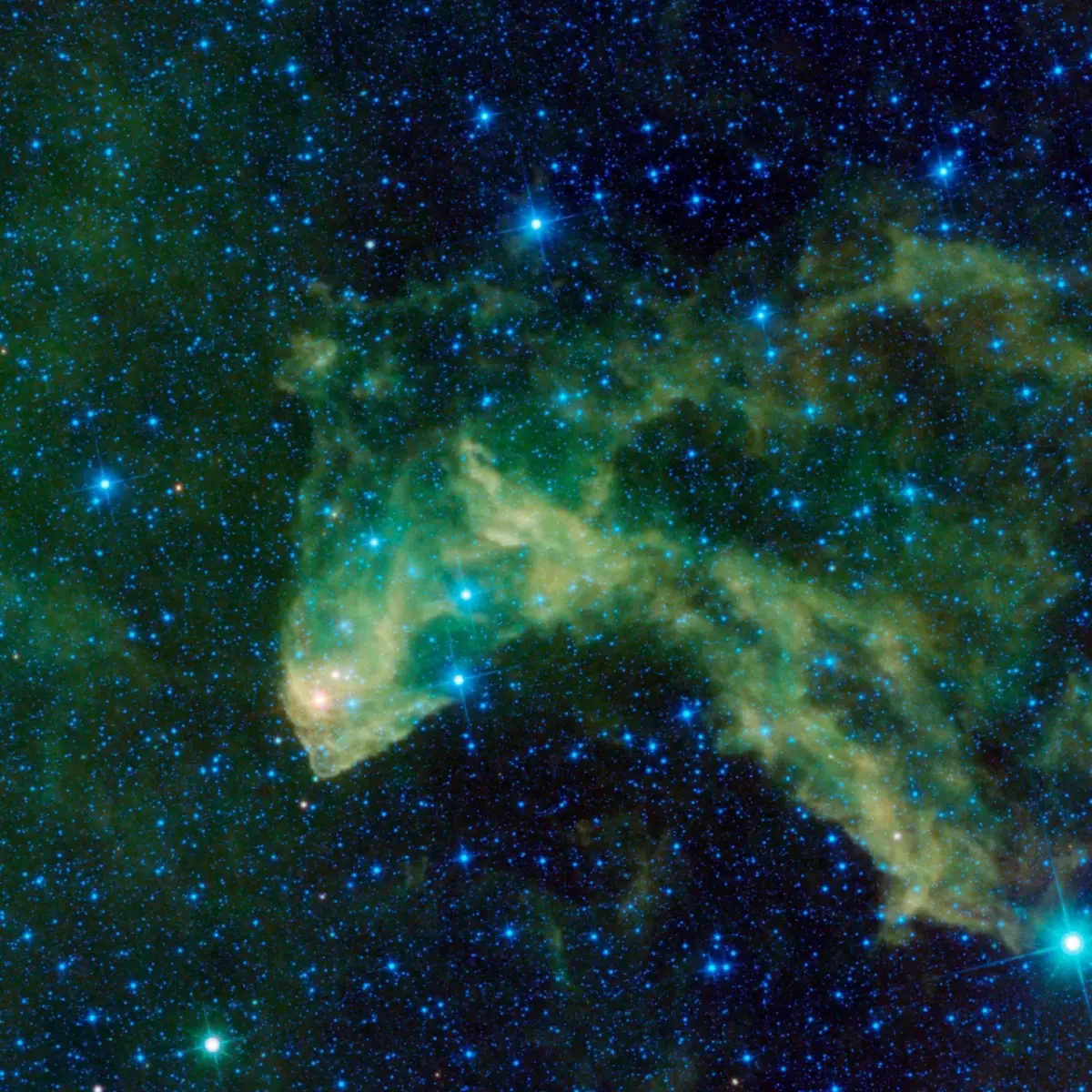
Sky gazers have dubbed this region the “Gecko Nebula” for its resemblance to a downturned head with a pointed snout, though astronomers refer to the area as LBN 437. This cloud of dust and gas is a region of star formation, which is revealed clearly in infrared light by NASA’s WISE mission. Image: NASA/JPL-Caltech/IPAC (PD)
Location
The Gecko Nebula is located in the same area of the sky as the famous Stephan’s Quintet and NGC 7331 with the Deer Lick Group of galaxies in the constellation Pegasus.
The Gecko and the Great Lacerta Nebula lie in a relatively faint region of the sky occupied by the celestial Lizard. They appear near the border with Andromeda, roughly halfway between Deneb, the star at the top of the Northern Cross in Cygnus, and Alpheratz, the brightest star in the Great Square of Pegasus. A line extended from Sadalbari (Mu Pegasi) through Matar (Eta Pegasi) points in the direction of the nebulae. Matar and Sadalbari form a triangle with Scheat (Beta Pegasi) in the Great Square.
The Great Lacerta Nebula is too large and faint to be observed visually. It is too large for large telescopes and too faint for binoculars. Like the Gecko Nebula, it is best seen in long-exposure photographs.
At declination +40° 40′, the nebulae are best seen from the northern hemisphere. They never rise above the horizon for observers south of the latitude 49° S.
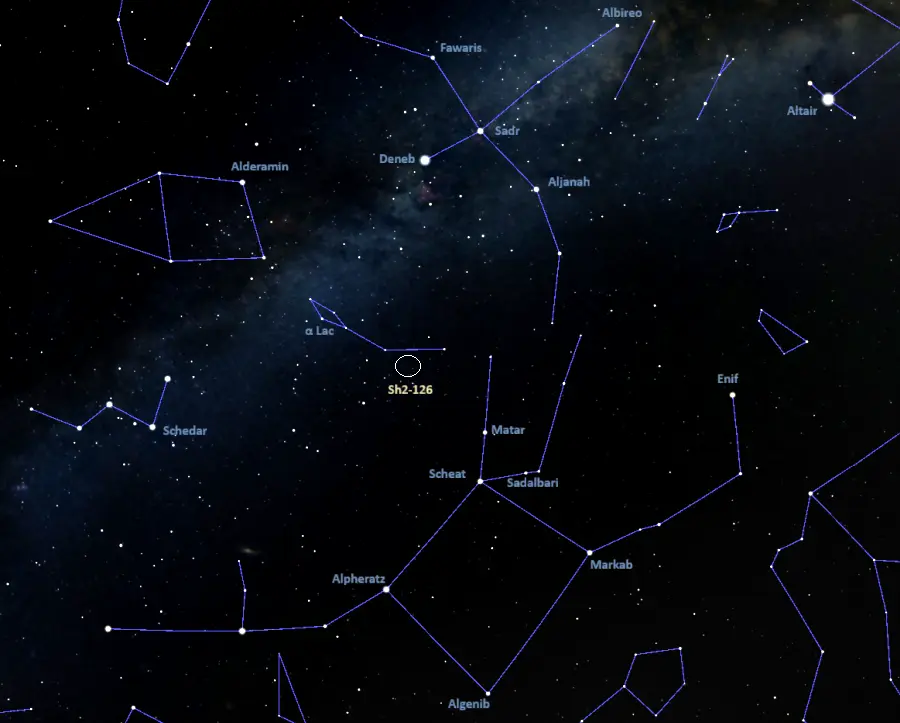
Great Lacerta Nebula location, image: Stellarium
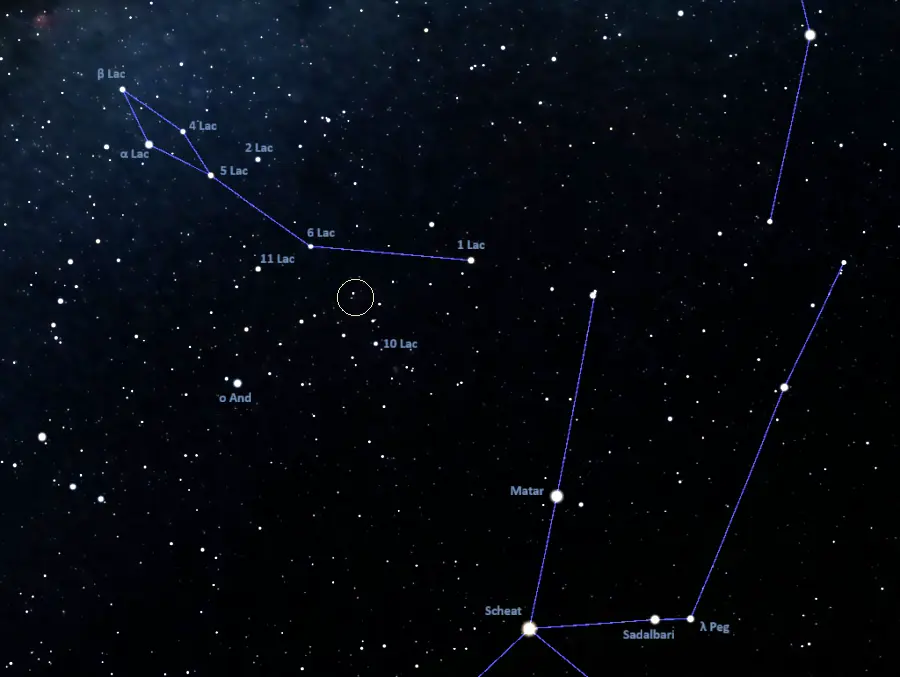
Gecko Nebula location, image: Stellarium
Gecko Nebula – LBN 437
| Constellation | Lacerta |
| Object type | Reflection nebula |
| Right ascension | 22h 32m 12.0s |
| Declination | +40° 35′ 00″ |
| Distance | 1,200 light-years (368 parsecs) |
| Names and designations | Gecko Nebula, LBN 437, LBN 096.26-14.97, DG 187, GAL 096-15 |
Great Lacerta Nebula – Sh2-126
| Constellation | Lacerta |
| Object type | H II region |
| Right ascension | 22h 34m 37.9s |
| Declination | +40° 40′ 00″ |
| Apparent size | ~3° |
| Distance | 1,200 light-years (368 parsecs) |
| Names and designations | Great Lacerta Nebula, the Gecko, Sharpless 126, Sh2-126, LBN 428, LBN 094.98-16.95 |